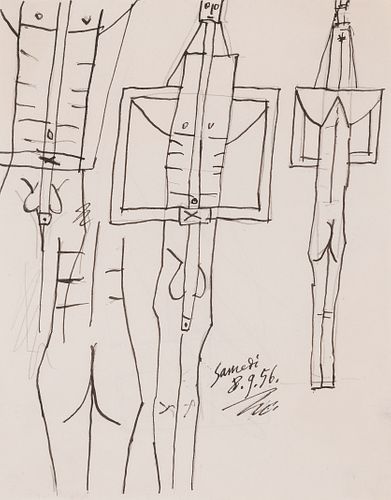PABLO RUIZ PICASSO (Málaga, 1881 – Mougins, 1973). "Sketch for the bathers", 1956. Mixed media on paper. Attach certificate issued by Claude Picasso.
Lot 76
About Seller
Setdart Auction House
Carrer Aragó 346
Barcelona
Spain
Setdart Subastas was born in 2004 and is currently the first online art auction in Spain with solidity, prestige and reliability guaranteed by our more than 60,000 users. Setdart has a young, dynamic and enterprising team ready to successfully manage the purchase and sale of art works through custom...Read more
Categories
Estimate:
$45,000 - $50,000
Absentee vs Live bid
Two ways to bid:
- Leave a max absentee bid and the platform will bid on your behalf up to your maximum bid during the live auction.
- Bid live during the auction and your bids will be submitted real-time to the auctioneer.
Bid Increments
| Price | Bid Increment |
|---|---|
| $0 | $10 |
| $200 | $25 |
| $500 | $50 |
| $1,000 | $100 |
| $3,000 | $200 |
| $5,000 | $500 |
| $10,000 | $1,000 |
| $20,000 | $2,000 |
| $50,000 | $5,000 |
About Auction
By Setdart Auction House
Jun 17, 2021
Set Reminder
2021-06-17 06:15:00
2021-06-17 06:15:00
America/New_York
Bidsquare
Bidsquare : 19th & 20th Century Contemporary Art - Select Lots
https://www.bidsquare.com/auctions/setdart-auction-house/19th-20th-century-contemporary-art---select-lots-7081
Setdart Auction House sofia@setdart.com
Setdart Auction House sofia@setdart.com
- Lot Description
PABLO RUIZ PICASSO (Málaga, 1881 – Mougins, 1973). "Sketch for the bathers", 1956. Mixed media on paper. Attach certificate issued by Claude Picasso. Dated in the lower right area. Presents an Krugier & Cie gallery label. Measures: 27 x 21 cm; 54 x 47.5 cm (frame). For Picasso the theme of bathers was a recurring motif in his painting. From the painting of his admired Cezanne, where he anticipates precepts that will later have an aesthetic development during cubism, to the bathers of Picasso's classical period. A period in which this theme played a major role. However, in this particular work, we find a more mature Picasso, who moves away from the forms of the classical period, exponentially synthesizing the figures and reducing them to a set of completely austere lines. Creator of cubism together with Braque, his capacity for invention and creation places him at the top of world painting. He was born in Malaga, where his father was a professor of drawing and director of the Municipal Museum. The Ruiz Picasso family soon moved to La Coruña, and from there to Barcelona, where the young Pablo began his artistic studies at the Provincial School of Fine Arts (1895). Although the school's style is totally academic, the painter soon comes into contact with modernist groups that change his form of expression. Only two years later, in 1897, Picasso had his first individual exhibition, in the café "Els Quatre Gats". Paris was to become Pablo's great goal and in 1900 he moved to the French capital for a brief period of time. When he returned to Barcelona, he began to work on a series of works in which the influences of all the artists he had known or whose work he had seen could be seen. He is a sponge that absorbs everything but retains nothing; he is searching for a personal style. Between 1901 and 1907 he developed the Blue and Pink Stages, characterized by the use of these colors and by their subject matter with sordid, isolated figures, with gestures of sorrow and suffering. The painting of these early years of the twentieth century was undergoing continuous changes and Picasso could not remain on the sidelines. He became interested in Cézanne, and based on his example he developed a new pictorial formula together with his friend Braque: Cubism. But Picasso did not stop there and in 1912 he practiced collage in painting; from that moment on, anything goes, imagination became the master of art. Picasso is the great revolutionary and when all the painters are interested in cubism, he is concerned with the classicism of Ingres. The surrealist movement of 1925 did not catch him unawares and, although he did not participate openly, it served as an element of rupture with the previous, introducing in his work distorted figures with great force and not exempt of rage and fury. As with Goya, Picasso was also greatly influenced by his personal and social situation at the time of his work. His relationships with women, often tumultuous, will seriously affect his work. However, what had the greatest impact on Picasso was the outbreak of the Spanish Civil War and the bombing of Guernica, which led to the creation of the most famous work of contemporary art. Paris was his refuge for a long time, but the last years of his life were spent in the south of France, working in a very personal style, with vivid colors and strange shapes. Picasso is represented in the most important museums around the world, such as the Metropolitan, the MOMA and the Guggenheim in New York, the Hermitage in St. Petersburg, the National Gallery in London or the Reina Sofia in Madrid.
- Shipping Info
-
In-house shipping available. Please inquire at admin@setdart.com.
-
- Buyer's Premium



 EUR
EUR CAD
CAD AUD
AUD GBP
GBP MXN
MXN HKD
HKD CNY
CNY MYR
MYR SEK
SEK SGD
SGD CHF
CHF THB
THB

















